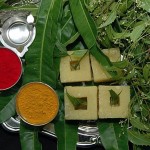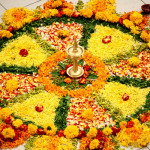Ugadi (Telugu:ఉగాది | Kannada:ಯುಗಾದಿ) or Gudi Padwa (Marathi:गुडी पाडवा) is celebrated on Chaitra Sukla Padyami as a mark of the beginning of the New Year in Southern part of India. Ugadi or Yugadi in Andhra Pradesh and Karnataka, Gudi Padwa in Maharashtra are based on lunar calendar thus the date changes yearly.
As a result of cultural variations in our country festivals are celebrated at different times and in different ways according to different regional culture. This might be seen in case of New Year as well. Maximum population of India follows Hinduism; even then New Year is not celebrated at the same time and in the same manner within the Hindu community. The varied cultures of Hinduism follow independent calendars; the New Year Day in these calendars is based on seasons and the agrarian economy of the region.
|
Telugu:ఉగాది |
Kannada:ಯುಗಾದಿ |
Marathi:गुडी पाडवा |
|
31st March, 2014 (Chaitra Sukla Padyami) |
||
.
The Lunar Calendar
The festival marks the New Year Day for people who follow the Indian Lunar Calendar (particularly in South India) when the Moon changes orbit. Hence, the festival is of utmost important for the people of South Indian states. This calendar reckons dates based on the Salivahana era (Salivahana Saka), which begins its count from the supposed date of the founding of the Empire by the legendary hero Salivahana. The Satavahana king Shalivahana (also identified as Gautamiputra Satakarni) is credited with the initiation of this era known as Shalivahana.
The Salivahana era begins its count of years from the year corresponding to 78 AD of the Gregorian calendar. Thus, the year 2000 AD corresponds to the year 1922 of the Salivahana Era.
While the South Indian states of Andhra Pradesh and Karnataka observe this day as Ugadi , Maharashtrians observe as Gudi Padwa. Spring is considered the first season of the year and hence is a symbol of heralding a new year and a new beginning. The spring marks the beginning of new life with plants acquiring new life, shoots and leaves.
.
- It is believed that Lord Brahma, the Creator, started creation on this day of Ugadi
-
One of the common customs during Ugadi is to tie fresh mango leaves over doorways on the day of the festival. It is believed that Subramanya (or Kartik or Kumara Swamy) and Ganesha, the sons of Lord Shiva and Parvathi were both fond of mangoes. Subramanya, in particular, is believed to have encouraged people to tie green mango leaves to doorways to signify to him that they had mangoes. This act has come to symbolise earning a good crop or general well-being for Ugadi and the New Year.
Cultures , Rituals and Festive:
According to Chandramana, Ugadi is celebrated on the bright fortnight (‘Shukla Paksha’) of the first month (‘Chaitra Masa’) in the first season of the year i.e. spring (‘Vasanta-Ritu’). As all these important elements are present, this day has special significance marking the commencement of a New Year.
Preparations for the festival begin a week ahead. Houses are given a thorough wash. Shopping for new clothes and buying other items that go with the requirements of the festival are done with a lot of excitement.
On Ugadi day, people wake up before the break of dawn and take a head bath after, which they decorate, the entrance of their houses with fresh mango leaves. The green mango leaves tied to the doorway signify a good crop and general well being. It is noteworthy that one uses mango leaves and coconuts (as in a ‘Kalasam’, to initiate any puja) only on auspicious occasions to propitiate gods.
People also splash fresh cow dung water on the ground in front of their house and draw colourful floral designs. This is a common sight in every household. People perform the ritualistic worship to God invoking his blessings before they start off with the New Year. They pray for their health, wealth and prosperity and success in business too. Ugadi is also the most auspicious time to start new ventures.
Ugadi is celebrated with festive fervor in the states of Maharashtra, Karnataka and Andhra Pradesh.
Preparations:
According to the traditions and rituals, preparations for the day of Ugadi begins a day or two prior to the actual date with ritualistic washing and cleaning of the houses, every inch and corner. Shopping for decorative items and new clothes to wear on the day is also an important custom that has been followed since one can remember. When the day dawns, ritualistic showers or oil baths are taken by the devotees; followed by prayers and chanting of mantras to facilitate good tidings in the year ahead. It is also believed that any venture that is started on this day ends in a success. After the baths, people start decorating their homes with colourful rangolis or Kolams that are drawn in the front and stringing together mango leaves on the doors and windows. According to an ancient tradition, people flock at the temples to listen to the predictions made by the pundits; this tradition is known as Panchanga Sravanam, which is still very popular as devotees eagerly wait for yearly forecast to be made. However, with the advent of technology and vast media coverage, many people prefer to watch this event on their television sets at homes.
Special Delicacies:
 Spring is the season for the King of Fruit that is Mango, the fragrance of the ripe mangoes spreads all around and the blossomed neem tree purifies the area. There are many special dishes made by adding Jaggery that is made from fresh sugar cane.
Spring is the season for the King of Fruit that is Mango, the fragrance of the ripe mangoes spreads all around and the blossomed neem tree purifies the area. There are many special dishes made by adding Jaggery that is made from fresh sugar cane.
Ugadi Pachchadi is a special dish that is compulsorily made from pieces of raw mangos. Neem flowers, tamarind and jaggery.The significance behind this dish is that life is a mixture of sorrow, joy, bad and good and we have to face this. After setting of the sun, again the next day it rises. All the experiences are a part of life.nd it is also promised that inspite of bad situations in this year accept with positive approach. Men should ascent above happiness, sorrow, failure and success. The special dishes like Pulihora, Bobbaltu and other dishes made up of raw mangoes are prepared in Andhra Pradesh.
Kavi Sammelanam:
Kavi Sammelanam also known as Poetry Recitation is also held. This is a typical feature of Telugu Ugadi.Ugadi is also the festival for the poetry lovers and the poets. Many famous poets attend this festival to read their new work and discuss it amongst the other poets present at the Kavi Sammelan.The subjects ranges from politics to lifestyles and modern trends.Ugadi Sammelan is considered to be the launching pad for many of the new budding poets. As the performances are carried, live on the Doordarshan, Hyderabad and All India Radio, Hyderabad. Poets from all walks of life and hues come here to participate in these cultural fests. The subjects range from satirical, literary, melancholic, political, reformist and comic.
.
Karnataka celebrates Ugadi festival in a grand manner. It is a grand festival for Kannadigas as any other people celebrate their respective new years. The day starts with a ritual elaborate oil bath. The bath is followed by wearing new cloths and offering prayers to the family, village, favorite and other deities. The doors especially the main entrance door will be decorated with festoons, flower garlands, bale kamba (plantain stems with leaves) will be tied. Fresh mango leaf bunches will be tied on either side f the main door and other doors. Fresh mango leaf thorana will be tied on the sill (top cross panel) of the door frame. As to the reason for tying the mango leaves is the reason attributed to the liking of mangoes by Subramanya (Karthikeaya or Kumara) and Ganesha. They are the sons of Lord Siva and goddess Parvathy. It is said that Karthikeaya suggested to people to tie the fresh mango leaves to the door way. This is to symbolize the wish for a good crop and prosperity of the family.
Significance of Ugadi celebrations
Ugadi or the New Year come after the Holi celebrations are over and it is time for the change of the climate to the spring. The spring season is supposed to be the first season of the year heralding new life of the year. The flowers on the trees, creepers and plants are in full bloom. The mangoes half way grown are going to mature soon spreading their own sweet aroma in the atmosphere. Many of the plants/trees start their new life with the sprouting of shoots, leaves and flowers in spring. The entire nature will appear to be at the peak of life and gay. Everywhere the nature will look growth, well beings and prosperity. The sweet fragrance and colors of the jasmine rose and other flowers will fill the atmosphere along with the senses and minds of the beholders. Apart from the decorations of the houses, deities/photos of gods, the ladies can be seen with the garlands of jasmine and other flowers tucked in their hair spreading the fragrance wherever they go. The fully blossomed Neem (Azadirachta indica – Indian Lilac) trees and honge trees (Milletia or Pongamia pinnata – Indian beech) makes the surrounding areas healthy by spreading their healing elements in the atmosphere. The making of the jaggery in villages and small towns and on the peripheries of the cities from the matured sugar cane crop helps to make sweet delicacies add flavor to the Ugadi environment while spreading its own aroma in the area. Incidentally this is also the season for making pickles to be preserved and used till the next season.
The social activity on the Ugadi day is arranging Kavi Sammelan where recitation of poetry is done.
Preparing for Ugadi celebrations
People start the preparation to celebrate Ugadi from one week to 10 days onwards before the festival day. The houses used to be color/white washed in the earlier years. Now it is distempering and done once in 4 – 5 years. Every item in the house will be taken out, dusted and cleaned and rearranged. The house floors will be washed thoroughly. On the previous day Rangolees (drawing patterns with watery rice color and other colors) will be drawn on the floors at important places like the entrances, hall and the pooja room etc. Hectic shopping may be done for buying new clothing and other items required for the celebration of the Ugadi festival. In the rural areas and small towns or places where old types of houses with compounds are found the front side court yards of the houses will be plastered with the cow dung liquid splashed to cleanse and adorn with Rangolees.
Special dishes of Ugadi festival
The eating of a special item of 6 tastes is a must signifying the fact that the life is a mixture of all feelings. The item made of 6 tastes are bitterness equivalent to the sadness, sweetness equal to happiness, hot taste equal to anger, saltiness signifying fear, sourness corresponding to disgust and the tang signifying surprise. The 6 items which are part of the special mix item for the day are the Neem buds and flowers; jaggery; green chilly/pepper; salt; tamarind and raw mango. This is to symbolize of our accepting the 6 feelings explained in our life as they come and go. Now it is mainly reduced to ‘Bevu, Bella’ (meaning Neem and jaggery).
Any festival in any religion is an event celebrated happily and for happiness. The Ugadi festival celebration is also similar. In any celebration of any religion one of the main items is the food. For every festival there will be at least one special dish if not more. Ugadi has its special dishes named Obbattu or Holige with coconut shredding or cooked dhal. Accordingly it will be called either kaai or bele holige/obbattu. The holige is eaten hot or cold with mostly ghee topping or occasionally with milk topping. Ugadi Pachchadi (dish of 6 tastes mentioned above) is another special Ugadi dish. The other items will be common to most of the festivals or functions like marriage, gruha pravesam etc.
Listening to panchang or almanac recitation
One of the rituals of Ugadi is to listen to the panchang/Almanac of the New Year read by someone conversant with it. This will consist of 5 elements f the day like the Nakshatra, thithi, vaara, masa, samvasara etc. But the panchang read on the Ugadi day will have a general forecast of the year as to what are the good and bad of the year in general for all. Now this ritual is mostly substituted by the watching of a relevant TV channel which may be doing this under the name to mean as Panchanga Sravanam, for the benefit f the viewer families. In the earlier years it used to be listened at the temples or Matts.
Other activates on Ugadi day
It varies with families and places. Some engage in literary and poetry discussions/discourses, Carnatic music recitation or dance. These are changed in many places with TV programs or light/film music and dance. Wishing each other the ‘Subhasayagalu’ (good wishes) is an important item.
.
Gudi Padwa is the Hindu New Year in Marathi culture as per traditional lunar calendar followed in Maharashtra. Gudi Padwa 2013 Date is April 11. It is observed mainly in Maharashtra. As per traditional Marathi calendar, this New Year is the Vijaya Nama Samvatsar and the Shri Shalivahan Shak 1935 begins on the day. The first month in the Marathi calendar is Chaitra and Gudi Padwa is observed on Chaitra 1 or the first day of Chaitra. The most important event on the day is the hoisting of the Gudhi (victory flags) in front of the homes.
There numerous reasons for observing Gudi Padwa – the most important legends are the defeat of Shakas by Shaliavahan and some people observe it to commemorate the victories of Chatrapati Shivaji Maharaj.
Gudi Hoisting
The most important event on the day is the hoisting of flags on a bamboo staff. The flag hoisted on Maharashtrian New Year is made of green or yellow colored silk cloth. A bright garlanded goblet Is hung on top of the flag pole. Neem leaves, mango leaves, garland of red flowers and gaohi (sweet) are hung on the Gudhi. Rangoli is drawn near the Gudi or in front of the house.
Gudi Padwa Offerings
Offering made of neem leaves and neem flowers and jaggery is distributed on the day. The offering consists of neem leaves and neem flowers, soaked dal, cumin seeds, honey or jaggery and asafetida. The offering symbolically indicates that life is filled with joy and sorrow.
Auspicious Day
Gudi Padva is one of the most auspicious days in the Marathi Hindu Calendar and is considered ideal for starting new ventures and investment. It is believed that every moment on the Gudhi Padwa day is auspicious. The day also heralds the arrival of the spring season. Farmers make it a point to plough the field on the Gudhi Padva day and they believe it will help in having a good harvest in the ensuing agricultural season.
.





No comments yet.